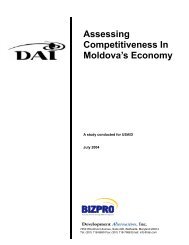Trade and Commercial Law Assessment - Honduras - Economic ...
Trade and Commercial Law Assessment - Honduras - Economic ...
Trade and Commercial Law Assessment - Honduras - Economic ...
Create successful ePaper yourself
Turn your PDF publications into a flip-book with our unique Google optimized e-Paper software.
TRADE AND COMMERCIAL LAW ASSESSMENT DECEMBER 2004<br />
HONDURAS<br />
♦ Real Property. The laws, procedures, <strong>and</strong> institutions responsible for establishing,<br />
maintaining, <strong>and</strong> preserving rights in real property, including l<strong>and</strong>, buildings, easements,<br />
liens, <strong>and</strong> other interests in real property<br />
♦ International <strong>Trade</strong>. The laws, procedures, <strong>and</strong> institutions governing cross-border sale<br />
of goods <strong>and</strong> services.<br />
With respect to the <strong>Trade</strong>Stream diagnostic, the areas of inquiry are as follows:<br />
♦ Flows of Goods <strong>and</strong> Services. Analyzes a nation’s ability to move goods <strong>and</strong> services<br />
smoothly through ports of entry <strong>and</strong> throughout the country.<br />
♦ Flows of Money <strong>and</strong> Flows of People. Similar to Goods <strong>and</strong> Services, these two sections<br />
look at a nation’s ability to facilitate the entry <strong>and</strong> exit of financing <strong>and</strong> short <strong>and</strong> long<br />
term business persons, respectively.<br />
♦ Supporting Infrastructure. Assesses the capacities of a country’s physical infrastructure<br />
relevant to trade, including sea- <strong>and</strong> airports, roads, railways, communications, <strong>and</strong> postal<br />
services.<br />
Within each of these substantive areas, four dimensions of CLIR were examined as a conceptual<br />
framework for comparison. These include the following:<br />
♦ Framework <strong>Law</strong>s. Basic legal documents that define <strong>and</strong> regulate the substantive rights,<br />
duties, <strong>and</strong> obligations of affected parties <strong>and</strong> provide the organizational m<strong>and</strong>ate for<br />
implementing institutions (e.g., <strong>Law</strong> on Bankruptcy, <strong>Law</strong> on Collateral, etc.)<br />
♦ Implementing Institutions. Governmental, quasi-governmental, or private institutions in<br />
which primary legal m<strong>and</strong>ate to implement, administer, interpret, or enforce framework<br />
laws is vested (e.g., bankruptcy court, collateral registry)<br />
♦ Supporting Institutions. Governmental, quasi-governmental, or private institutions that<br />
either support or facilitate the implementation, administration, interpretation, or<br />
enforcement of framework laws (e.g., bankruptcy trustees, notaries)<br />
♦ Social Dynamic/Market for reform. The interplay of stakeholder interests within a<br />
given society, jurisdiction, or group that, in aggregate, exert an influence over the<br />
substance, pace, or direction of commercial law reform.<br />
B. THE METHODOLOGY OF ASSESSMENT: A 360° REVIEW<br />
The methodology employed in examining <strong>Honduras</strong>’s CLIR <strong>and</strong> trade environment provides a<br />
comprehensive but flexible framework for analyzing a complex, dynamic development<br />
challenge. Taking data from a broad spectrum of stakeholders, the <strong>Assessment</strong> builds a 360°<br />
picture of the challenge, drawn from the following areas:<br />
♦ Legal Framework. The <strong>Assessment</strong> first examines the laws <strong>and</strong> regulations that<br />
<strong>Honduras</strong> has in place that serve as the structural basis for its achievement of marketbased<br />
development. Often this review discovered opportunities to make relatively small<br />
changes that could produce significant openings for business development <strong>and</strong> expansion.<br />
♦ Implementing Institutions. Next, the <strong>Assessment</strong> examines the administrative bodies<br />
with primary responsibility for implementing <strong>and</strong> enforcing the legal framework <strong>and</strong><br />
I-4

















